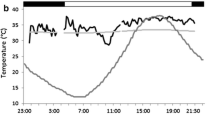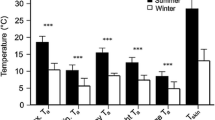Abstract
Daily torpor can provide significant energy and water savings in bats during cold ambient temperatures and food scarcity. However, it may reduce rates of foetal and juvenile development. Therefore, reproductive females should optimize development by minimizing times in torpor. To test this hypothesis, the use of torpor by female and male free-ranging Daubenton’s bats (Myotis daubentonii) during reproduction (gestation, lactation, and post-lactation period) was investigated in 1998 and 1999. Temperature-sensitive radio transmitters were attached to the bats to measure skin temperature. Simultaneously, ambient temperature was recorded. While both sexes became torpid during daytime, male bats used daily torpor (>6°C below individual active temperature) significantly more often during reproductive period (mean: 78.4 % of day time in May and 43 % in June) than females. Female bats went into daily torpor, particularly in late summer when juveniles were weaned (mean: 66.6 % of daytime). Lowest skin temperatures occurred in a female bat with 21.0°C during post-lactation. Skin temperatures of male bats fluctuated from 16.8°C in torpor to 37.2°C during times of activity. There was a significant effect of reproductive period on skin temperature in females whereas mean ambient temperature had no significant effect. However, mean ambient temperature affected mean skin temperatures in males. Our findings indicate that female Daubenton’s bats adopt their thermoregulatory behaviour in particular to optimize the juvenile development.



Similar content being viewed by others
Abbreviations
- DEE:
-
Daily energy expenditure
- T a :
-
Ambient temperature
- T s :
-
Skin temperature
- Preg:
-
Pregnant
- Lac:
-
Lactating
- post-lac:
-
Post-lactating
References
Aldridge HDJN, Brigham RM (1988) Load carrying and maneuverability in an insectivorous bat: a test of the 5% “rule” of radiotelemetry. J Mammal 69:379–382
Anthony ELP (1988) Age determination in bats. In: Kunz TH (ed) Ecological and behavioural methods for the study of bats. London Smithsonian Institution Press, Washington DC, pp 1–28
Anthony ELP, Kunz TH (1977) Feeding strategies of the little brown bat, Myotis lucifugus, in southern New Hampshire. Ecology 58:775–786
Arlettaz R, Christe P, Lugon A, Perrin N, Vogel P (2001) Food availability dictates timing of parturition in insectivorous mouse-eared bats. Oikos 95:105–111
Arnold W, Ruf T, Reimoser S, Tataruch F, Onderschka K, Schober F (2003) Nocturnal hypometabolism as an overwintering strategy of red deer (Cervus elaphus). Am J Physiol Regul Integr Comp Physiol 286:174–181
Audet D, Fenton MB (1988) Heterothermy and the use of torpor by the bat Eptesicus fuscus (Chiroptera: Vespertilionidae): a field study. Physiol Zool 61:197–204
Audet D (1992) Roost quality, foraging and young production in the mouse-eared bat Myotis myotis: a test of the ESS model of group size selection. Phd. Dissertation, York University ON, Canada, pp 127
Audet D, Thomas DW (1996) Evaluation of the accuracy of body temperature measurement using external radio transmitters. Can J Zool 74:1778–1781
Audet D, Thomas DW (1997) Facultative hypothermia as a thermoregulatory strategy in the phyllostomid bats, Carollia perspicilliata and Sturnia lilium. J Comp Physiol B 167:146–152
Barclay RMR, Kalcounis MC, Crampton LH, Stefan C, Maarten JV, Wilkinson L, Brigham M (1996) Can external radiotransmitters be used to assess body temperature and torpor in bats? J Mammal 77:1102–1106
Barclay RMR, Lausen CL, Hollis L (2001) What’s hot and what’s not: defining torpor in free-ranging birds and mammals. Can J Zool 79:1885–1890
Beck A (1995) Fecal analyses of European bat species. Myotis 32/33:109–119
Coburn DK, Geiser F (1998) Seasonal changes in energetics and torpor patterns in the subtropical blossom-bat Syconycteris australis (Megachiroptera). Oecology 113:467–473
Chruszcz BJ, Barclay RMR (2002) Thermoregulatory ecology of a solitary bat, Myotis evotis, roosting in rock crevices. Func Ecol 16:18–26
Dietz M, Fitzenräuter B (1996) Zur Flugroutennutzung einer Wasserfledermauspopulation (Myotis daubentoni Kuhl, 1819) im Stadtbereich von Gießen. Säugetierkd Inf 4(20):107–116
Eisentraut M (1937) Die Wirkung niedriger Temperaturen auf die Embryonalentwicklung bei Fledermäusen. Biologisches Zentralbl 57:59–74
Encarnação J, Dietz M, Kierdorf U (2004) Reproductive condition and activity pattern of male Daubenton’s bats (Myotis daubentonii) in the summer habitat. Mamm biol 69:163–172
Enwistle AC, Racey PA, Speakman JR (1998) The reproductive cycle and determination of sexual maturity in male brown long.eared bats, Plecotus auritus (Chiroptera: Vespertilionidae). J Zool 244:63–70
Fowler PA (1988) Thermoregulation in the female hedgehog, Erinaceus europaeus, during the breeding season. J Reprod Fert 82:285–292
Furlonger CL, Dewar HJ, Fenton MB (1987) Habitat use by foraging insectivorous bats. Can J Zool 65:284–288
Geiser F, Ruf T (1995) Hibernation versus daily torpor in mammals and birds: physiological variables and classification of torpor patterns. Physiol Zool 68:935–966
Grimmberger E, Hackethal H, Urbanczyk Z (1987) Beitrag zum Paarungsverhalten der Wasserfledermaus, Myotis daubentoni (Kuhl, 1819), im Winterquartier. Zeitschr Säugetierkde 52:133–140
Grinevitch L, Holroyd SL, Barclay RM (1995) Sex differences in the use of daily torpor and foraging time by big brown bats (Eptesicus fuscus) during the reproductive season. J Zool 235:301–309
Hamilton IM, Barclay RMR (1994) Patterns of daily torpor and day-roost selection by male and female big brown bats (Eptesicus fuscus). Can J Zool 72:744–749
Hamilton IM, Barclay RMR (1998) Diets of juvenile, yearling, and adult big brown bats (Eptesicus fuscus) in southeastern Alberta. J Mammal 79:764–771
Haarje C (1994) Etho-ökologische Untersuchung der ganzjährigen Aktivität von Wasserfledermäusen (Myotis daubentoni Kuhl, 1819) am Winterquartier. Mitt Natf Ges Schaffhausen 39:15–52
Hickey MBC, Fenton MB (1996) Behavioural and thermoregulatory responses of female hoary bats, Lasiurus cinereus (Chiroptera: Vespertilionidae), to variations in prey availability. Ecoscience 3:414–422
Hosken DJ (1997) Thermal biology and metabolism of the greater long-eared bat, Nyctophilus major (Chiroptera: Vespertilionidae). Aust J Zool 45:145–156
Jolly SE, Blackshaw AW (1987) Prolonged epididymal sperm storage, and the temporal dissociation of testicular and accessory gland activity in the common sheat-tail bat. J Reprod Fert 81:205–211
Jones G, Rayner JMV (1988) Flight performance, foraging tactics and echolocation in free-living Daubenton’s bats Myotis daubentonii (Chiroptera: Vespertilionidae). J Zool 215:113–132
Kalko EKV, Schnitzler HU (1989) The echolocation and hunting behaviour of Daubenton’s bat, Myotis daubentoni. Behav Ecol Sociobiol 24:225–238
Kerth G, Weissmann K, König B (2001) Day roost selection in female Bechstein`s bats (Myotis bechsteinii): a field experiment to determine the influence of roost temperature. Oecology 126:1–9
Körtner G, Brigham RM, Geiser F (2001) Torpor in free-ranging tawny frogmouth (Podargus strigoides). Physiol Biochem Zool 74:789–797
Kunz TH (1974) Feeding ecology of a temperate insectivorous bat (Myotis velifer). Ecology 55:693–711
Kurta A (1986) Factors affecting the resting and postflight body temperature of little brown bats, Myotis lucifugus. Physiol Zool 59:429–438
Kurta A, Johnson KA, Kunz TH (1987) Oxygen consumption and body temperature of female little brown bats (Myotis lucifugus) under simulated roost conditions. Physiol Zool 60:386–397
Kurta A, Kunz TH (1988) Roosting metabolic rate and body temperature of male little brown bats (Myotis lucifugus) in summer. J Mammal 69:645–651
Kurta A, Bell GP, Nagy KA, Kunz TH (1989) Energetics of pregnancy and lactation in free-ranging Little Brown Bats (Myotis lucifugus). Physiol Zool 62:804–818
Kurta A (1990) Torpor patterns in food-deprived Myotis lucifugus (Chiroptera: Vespertilionidae) under simulated roost conditions. Can J Zool 69:255–257
Kurtze W (1974) Synökologische und experimentelle Untersuchungen zur Nachtaktivität von Insekten. Zool Jb Syst 101:297–344
Lausen CL, Barclay RMR (2003) Thermoregulation and roost selection by reproductive female big brown bats (Eptesicus fuscus) roosting in rock crevices. J Zool 260:235–244
Lewis T, Taylor LR (1964) Diurnal periodicity of flight insects. Proc Trans R Ent Soc Lond 116:393–476
McLean JA, Speakman JR (2000) Effects of body mass and reproduction on the basal metabolic rate of brown-long-eared bats (Plecotus auritus). Physiol Biochem Zool 73:12–21
McNab BK (1982) Evolutionary alternatives in the physiological ecology of bats. In: Kunz TH (ed) Ecology of bats. Plenum Publishing, London New York, pp 151–197
Neuweiler G (1993) Biologie der Fledermäuse. Thieme, Stuttgart New York
Prinzinger R, Göppel R, Lorenz A, Kulzer E (1981) Body temperature and metabolism in the Red-backed Mousebird (Colius castanotus) during fasting and torpor. Comp Biochem Physiol 69A:689–692
Racey PA (1973) The viability of spermatozoa after prolonged storage by male and female European bats. Period Biol 75:201–205
Racey PA, Swift SM (1981) Variations in gestation length in a colony of pipistrelle bats (Pipistrellus pipistrellus) from year to year. J Reprod Fert 61:123–129
Racey PA (1988) Reproductive assessement in bats. In: Kunz TH (eds) Ecological and behavioural methods for the study of bats. Smithsonian Institute Press, Washington DC, pp 31–46
Racey PA, Tam WH (1974) Reproduction in male Pipistrellus pipistrellus (Mammalia: Chiroptera). J Zool 172:101–122
Racey PA, Swift SM (1985) Feeding ecology of Pipistrellus pipistrellus (Chiroptera: Vespertilionidae) during pregnancy and lactation. I. Foraging behaviour. J Anim Ecol 54:205–215
Racey PA, Speakman JR (1987) The energy costs of pregnancy and lactation in heterothermic bats. Symp Zool Soc Lond 57:107–125
Ransome R (1968) The distribution of the greater horseshoe bat, Rhinolophus ferrumequinum, during hibernation, in relation to environmental factors. J Zool 154:77–112
Reynolds DS, Kunz TH (2000) Changes in body composition during reproduction and postnatal growth in the Little Brown bat, Myotis lucifugus (Chiroptera: Vespertilionidae). Ecoscience 7(1):10–17
Roer H, Egsbaek W (1969) Über die Balz der Wasserfledermaus (Myotis daubentoni) (Chiroptera) im Winterquartier. Lynx 10:85–91
Rydell J (1992) Occurrence of bats in northernmost Sweden (65°N) and their feeding ecology in summer. J Zool 227:517–529
Schmid J (2000) Torpor in the tropics: the case of the gray mouse lemur (Microcebus murinus). Basic Appl Ecol 1:133–139
Schmid J, Ruf T, Heldmaier G (2000) Metabolism and temperature regulation during daily torpor in the smallest primate, the pygmy mouse lemur (Microcebus myoxinus) in Madagascar. J Comp Physiol 170:59–68
Studier EH (1981) Energetic advantages of slight drops in body temperature in little brown bat, Myotis lucifugus. Comp Biochem Physiol A 70:537–540
Swift SM, Racey P (1983) Ressource partitioning in two species of vespertilionid bats (Chiroptera: Vespertilionidae) occupying the same roost. J Zool 200:249–259
Thomas DW, Dorais M, Bergeron JM (1990) Winter energy budgets and cost of arousals for hibernating Little Brown bats, Myotis lucifugus. J Mammal 71:475–479
Wang LCH, Wolowyk MW (1988) Torpor in mammals and birds. Can J Zool 66:133–137
Webb PI, Speakman JR, Racey PA (1993) The implication of small reductions in body temperature for radiant and convective heat loss in resting endothermic brown long-eared bats (Plecotus auritus). J Therm Biol 18:131–135
White GC, Garrott RA (1990) Analysis of wildlife radio-tracking data. Academic Press, San Diego
Wilde CJ, Kerr MA, Knight CH, Racey PA (1995) Lactation in vespertilionid bats. Symp Zool Soc Lond 67:139–149
Wilde CJ, Knight CH, Racey PA (1999) Influence of torpor on milk protein composition and secretion in lactating bats. J Exp Zool 284:35–41
Willis CKR, Brigham RM (2003) Defining torpor in free-ranging bats: experimental evaluation of external temperature-sensitive radiotransmitters and the concept of active temperature. J Comp Physiol B 172:379–389
Acknowledgements
The authors gratefully acknowledge the help of all the people who supported the time intensive field-work. We are particularly grateful to Dr. Jutta Schmid, Dr. Jorge Encarnação, Sabine Springer and two anonymous referees, who greatly improved the manuscript by valuable comments. Handling of Daubenton’s bats was done under licence from the nature conservancy department of the Regierungspräsidium Gießen.
Author information
Authors and Affiliations
Corresponding author
Additional information
Communicated by G. Heldmaier
Rights and permissions
About this article
Cite this article
Dietz, M., Kalko, E.K. Seasonal changes in daily torpor patterns of free-ranging female and male Daubenton’s bats (Myotis daubentonii). J Comp Physiol B 176, 223–231 (2006). https://doi.org/10.1007/s00360-005-0043-x
Received:
Revised:
Accepted:
Published:
Issue Date:
DOI: https://doi.org/10.1007/s00360-005-0043-x




